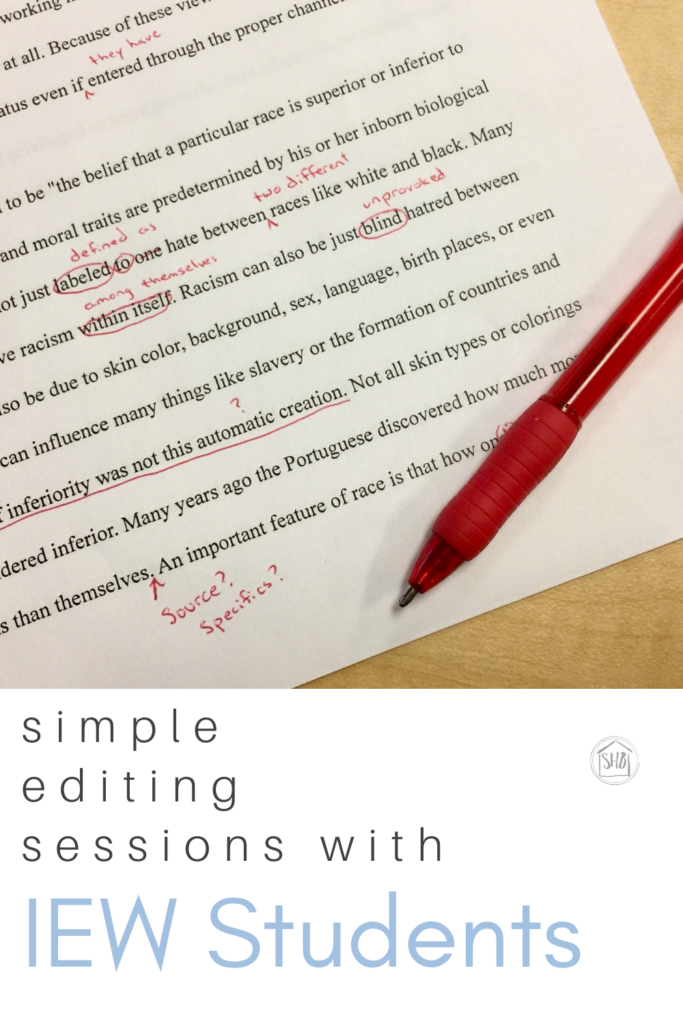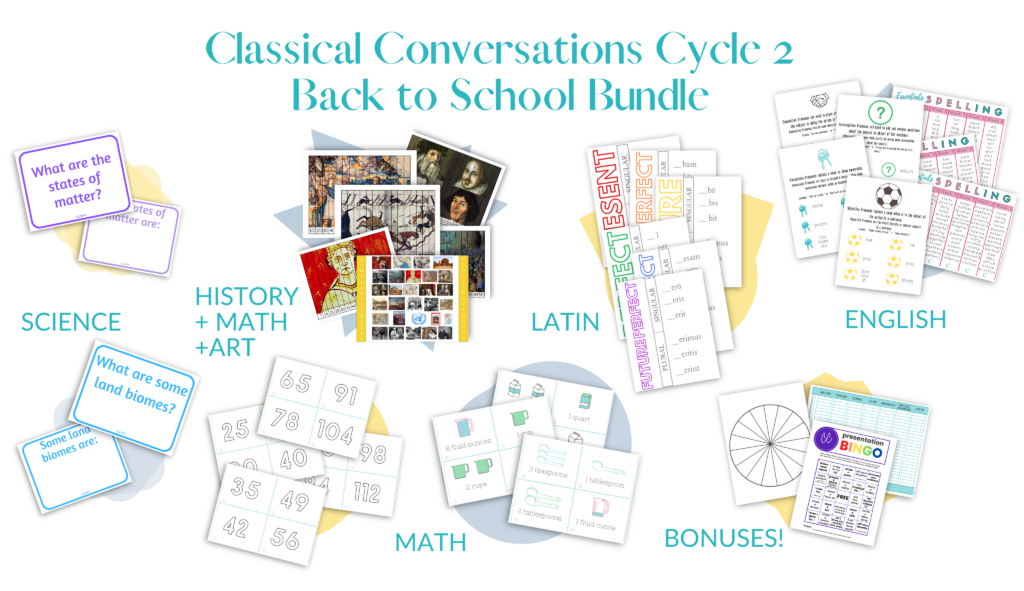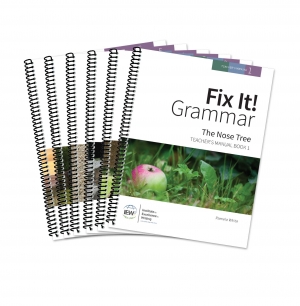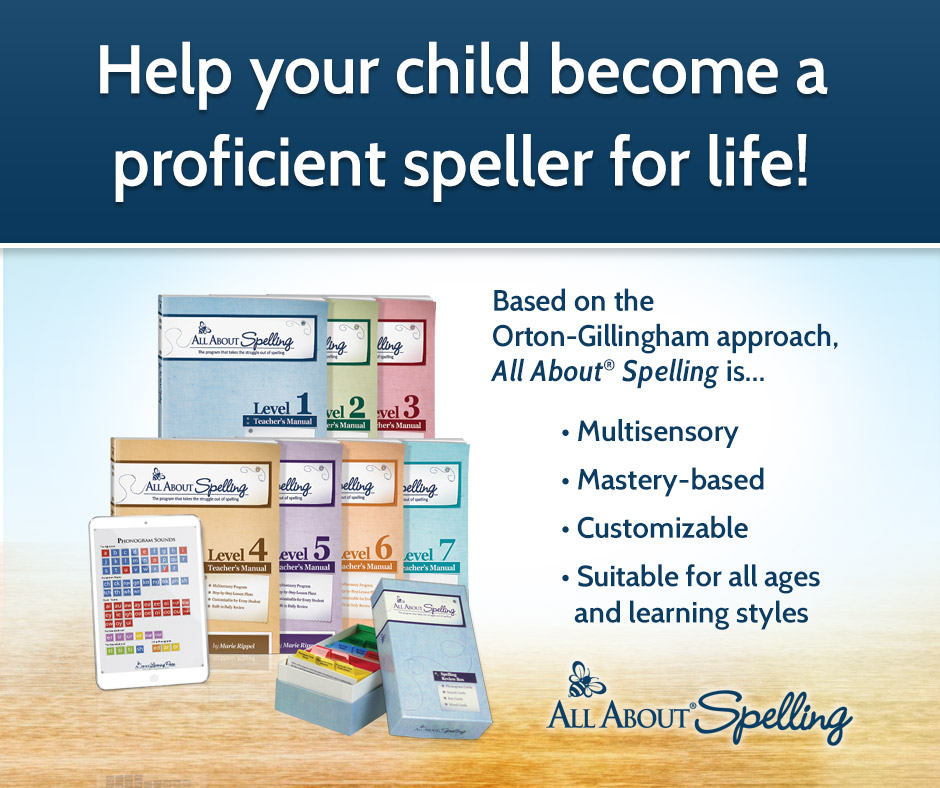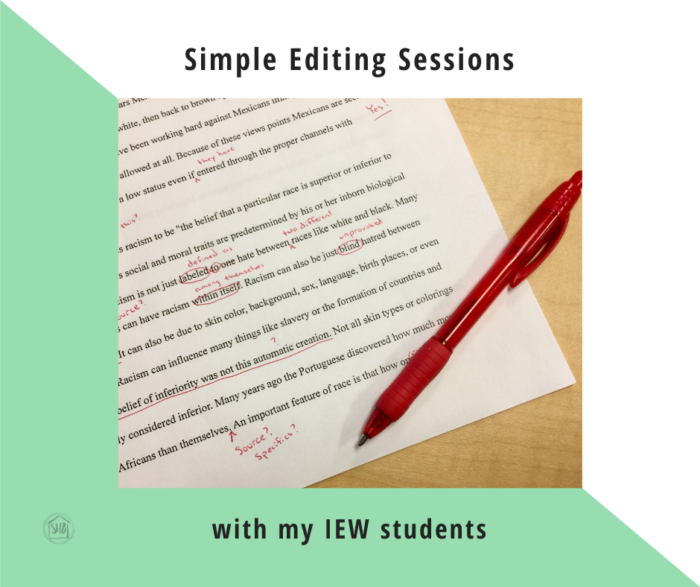
This is our second tour of Essentials with our oldest student. She is currently 10, a natural artist, and a budding writer. I find her to be quite an impressive young lady – but I have absolutely no claim to bias-free reviews of my children. Last year we focused on getting the lay of the land when it comes to writing. In the years leading up to Essentials and IEW, we had never worked through a formal (or informal) writing program. We focused in the early years on grammar and copywork.
When we got to the end of our first year of Essentials, my student and I talked about what we liked about the year. Both of us agreed our favorite part of Essentials writing was our editing sessions. They were like little celebrations each week! And we love the celebratory nature of our homeschool.
I have been meaning to sit down and write about our editing sessions since the conclusion of last year. But time and projects intervened in my intentions. When we completed our first editing session of the year yesterday morning, I decided it was time to sit down and put my thoughts to keyboard.
This post may include affiliate links. If you click and make a purchase based on my recommendation, I get a small remuneration at no extra expense to you. I only recommend things I use and believe to be a blessing.
I am going to preface this post with a major disclaimer. Please pay attention to it because it is important.
DISCLAIMER: We do not have a struggling writer at this stage of elementary. We actually love and value writing and are working together to improve our writing.
If your student is not interested in writing, much less improving on her writing, seek advice for that particular malady elsewhere.
Addendum to the Disclaimer: We are not perfect in in any aspect of life or homeschooling. I am not writing this because I have gotten it all figured out. I am just writing about what has worked for us to not only get the job done, but also to infuse our days with joy (and maybe a bit of fun).
Editing Sessions Details
We follow a simple process throughout the week to get the “work” for Essentials done. I have a little cheat sheet to help me along the way. My student, as a second tour student, is able to do the majority of the work on her own. Once she is done with the rough draft of the paper for the week, we set a time for our Editing Session.
Since we have a Monday community day, Editing Sessions usually occur on Saturday morning or Sunday afternoon. That gives my student enough time to do her final draft of the paper before heading to class on Monday.
The student brings her rough draft to the table and I head to our family white board. She dictates the first paragraph of the paper to me, as I write it out on the board, leaving space for “editing.” When she is finished dictating the first paragraph, I go through and underline a few items which I see off the top of my head to address. Then we talk through the edits we need to make to the paper. I kind of broke them down into categories below. It ends up looking a lot more organic than a checklist – resembling a discussion rather than a teaching session.
Once the student has applied all the edits to paragraph one of her paper, we repeat the process for all the rest of the paragraphs, taking a break as needed.
#1 My Teacher Rule
I need to take a moment here to mention my #1 Teacher Rule. It is super simple, but is HARD to follow with younger students. I have been using this rule for years for teaching all ages. It is life-altering. Wanna hear it?
ONLY WRITE WHAT THE STUDENT SAYS ON THE BOARD
This rule is the reason I have my student dictate her paper to me. This rule is the reason we do our editing sessions on the board.
Only writing what the student says validates her thoughts and her writing. Only writing what the student affirms her abilities.
Grammar Informs Clear Writing
Since I am prone to grammar geekiness, I approach a lot of the Editing Session from a grammar perspective. That means many of the questions posed in editing are related to the definitions of the various parts of speech.
When we are trying to add dress-ups to her papers, we are looking for the part of speech we want to dress-up. We will say the definition of the dress-up part of speech (e.g. adjective, adverb) and ask what it is supposed to modify. Then we will try to figure out which word we want to modify – is it a noun, an adjective, a verb or adverb?
When a word choice is off in a paper, it is usually immediately clear to the reader. The writer – of course – knows what she was intending to say. So she may or may not see it immediately. Asking the simple questions – some embedded in the definitions of the parts of speech – will help to bring clarity to the paper.
An Example
For example. In her paper yesterday, my student wrote:
“They used sewage aqueducts to take dirty water out.”
The questions I had for her were: “Who used sewage aqueducts? What part of speech is they?” Since they is a pronoun and we know we use a pronoun to avoid repetition – are we avoiding repetition here? Or have we not even mentioned who “they” are? She immediately decided “they” were “Romans,” immediately adding clarity to this sentence.
My next question was: “What part of speech is ‘out’ in this sentence?” She accurately decided it was a preposition. I followed up on this discovery by asking her if this preposition was part of a prepositional phrase. In this case, she realized it wasn’t. The definition “a preposition relates a noun or pronoun to another word” informed her she had a preposition without a noun. She added the noun “cities” to remedy this situation. Once we had determined a noun for the preposition, we could decide if “out” was the best preposition for this thought.
When we were done editing this particular sentence, the improved sentence was:
“Romans used sewage aqueducts to take dirty water away from the cities.”
Much clearer, right?
Structure Over Style
In Andrew Pudewa’s lectures on the IEW methods, he speaks of “hands on structure, hands off style.” This is the way thousands of students can take the same writing course each year and produce wildly varying papers. The development of both style and structure through Essentials is one of the benefits of the program.
Word choice is not up for discussion unless it contributes to the structure and the clear communication of the subject. The student gets to say what she wants to say the way she wants to say it.
Unless….what she says:
- doesn’t make sense. – Lacking ordered, organized thinking where one concept flows into the next without gaps is what I am talking about. It is usually easily remedied.
- isn’t accurate. – Especially when it comes to history writing, we want to get the details right.
- is inappropriate to the topic. Ensuring a subject is approached properly is important to understand when to use the stylistic techniques in which situation.
My job as editor in chief of my homeschool is to help my student begin to see the structure details, even as she maintains her writing style. Helping her to understand how to dress up her writing in various purposes – history-telling, scientific papers, or persuasion – is my goal. Making sure the writing is clear and accurate are supreme, as well.
An Example
Many times in an Editing Session, my student has wanted to express an idea, but the way she wrote it was not clear. For example, in her paper yesterday, she wrote this sentence:
“The water drifted into tanks and fountains and used a system so that Romans could use water from sixty miles away.”
I gently told my student I didn’t understand what she was trying to say. We had a discussion about what she was trying to say. Initially, she said she was trying to say just what she wrote and couldn’t change any of the words to help me understand what she was trying to say.
I took a different tack and asked her, “What is the system you are talking about? A system of what?” Finally, she realized the system she was talking about was the system of aqueducts, tanks, and fountains. So we changed the sentence together to reflect this concept more clearly. The edited sentence went like this:
“Using a system of aqueducts, tanks, and fountains, Romans could use water from sixty miles away.”
The result is much clearer because of the structure.
Search and Suggest
One of the reasons my student remains enthusiastic about writing and not reluctant about improving upon her papers, is she gets to play with words. We are a word-loving family. Often we talk about the definitions of words, play with homophones, and try to find the “best word” for situations. So, my student loves using Portable Walls and the old (no-longer available) Student Resource Notebook. She gets to find lots of options for similar words to select the “just right” one for her purposes.
We also utilize Thesaurus.com to look for words. She loves using a thesaurus! I have considered getting A Word Write Now, but I just haven’t yet. I hear good things!
When we are looking for a new quality adjective or a strong verb, we like to have a list of options to choose from. Then she can select the one she likes the most.
Tip: To help my student recognize places where a better adjective or adverb may be needed, I will often look at the places where she has used an article adjective or a weak verb. Those articles are helpful for identifying a noun, but to describe the noun more accurately, there are so many more wonderful words. Similarly, a weak verb can be strengthened with the addition of an -ly adverb.
This year I am also making a point to suggest the addition of vocabulary words into her papers. This was often overlooked last year. This year I simply ask, “Do you think one of your vocabulary words would fit into this paragraph?” So far, she has adeptly added vocabulary words to her paragraphs.
An Approach to Checklists
I am not much for “grades” in my homeschool. Living in a state which does not require any sort of reporting, I am not in the habit of giving my students any sort of evaluations or “grades.” That is not to say I have no idea how my students would do if I gave them a test. I am confident of all my students’ strengths and weaknesses because I am learning alongside them every day.
So, when it comes to the checklists at the end of each IEW unit, I don’t ignore them altogether. But I do not mark my student’s papers and do not have them mark their papers to reflect the various dress-ups. We do use the checklist as we work through our Editing Sessions, but only to make sure we are on track with the program.
We do not have to turn in our papers to anyone, so I don’t feel the need to have my student attach the checklist to the front of her paper (with the rough draft included). Thus we simply celebrate the completion of the paper!
What I Left Out
Infused in the very fabric of our homeschool is a general celebratory tone which is not easily reflected in these types of articles. It is hard to express the affirmations included in our homeschool. When my student has written a beautiful sentence, we take a moment to bask in its simple brilliance. It doesn’t take long, but it encourages her to achieve those sorts of accolades each time she sits down to write.
Editing Sessions can be hard. Often they can feel critical instead of supportive. Correction is hard to take on – for the teacher and the student. If you sense your student is feeling less than confident, make sure to take a moment to point out what is brilliant in her writing! I have an Alliterative Affirmations Bookmark which helps me to make the celebrations of accomplishment just a bit more enjoyable and fun.
One of the things I learned from reviewing last year’s papers at the end of the year was I need to actually read my student’s rough drafts to edit the spelling. Despite my student being an extremely proficient speller (thanks All About Spelling!), she is not always thinking about spelling rules when she is working so hard to write beautifully. Thus, her papers are riddled with spelling errors. Most of the time, all I need to do is draw her attention to them. She can correct the errors herself.
Essentials Help for You
I came up with two simple weekly schedules/checklists for the Essentials years. It was born out of my own sense of overwhelm with “all the things” I needed to make sure my student did each week. Putting it on paper made me realize it wasn’t as big as I was making it. It was actually rather simple.
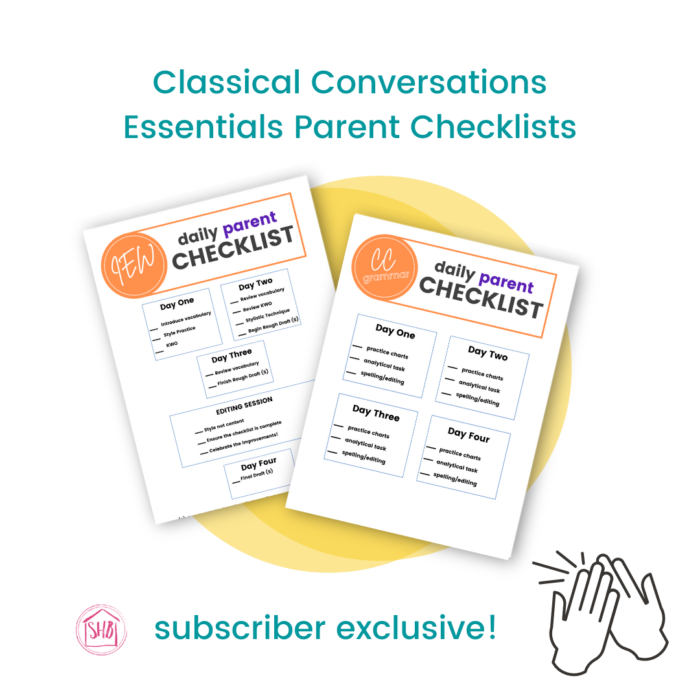
If you would like a copy of it, I would love to share it with you. I have a special CC Friends email list. I try to send out encouraging emails with helpful tips and resources to help you in your CC journey. You can join it here:
I have started writing enough about Classical Conversations that I created a segment of my mailing list devoted to CC. If you are interested in receiving updates on our CC journey, encouragement for your CC journey, and notification of new resources to help you, please sign up here. If you are already a subscriber, it will NOT double-subscribe you.
If you are looking for more expert advice, I recommend listening to IEW’s podcasts.
